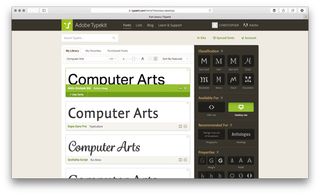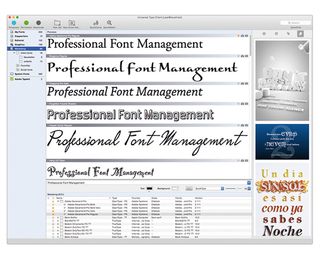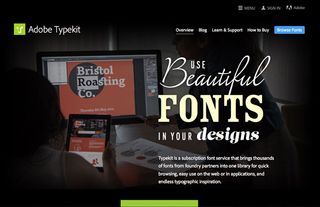5 tips for taking control of your fonts
Are the fonts you're using correctly licensed? Christopher Phin fills you in on the incredibly important business of font management.
Fonts are tricky. On the one hand, they are the result of many thousands of hours of skilful work, created by someone who should be fairly compensated.
On the other hand, most of us have to consciously remind ourselves that fonts must be licensed, in almost exactly the same way as the software you use on your Mac or PC. In fact, fonts are even harder to keep track of because it's not a simple binary 'it's licensed/it's not licensed' issue. Luckily, we also have a complete guide to font licensing that'll keep you on the straight and narrow.
"Because fonts licences can be very specific about uses – embeddable in PDFs, for eBook use, as a web font, and so on – it's important that users track not only each licence, but the parameters of the licence as well," says Jim Kidwell, senior product manager at Extensis. "Going outside of licence parameters has definitely led to lawsuits in recent years."
One of the most recent high-profile cases involved NBC Universal, which was hit with a $1.5 million suit because of its use of a font on some Harry Potter merchandise; the media company also faced a separate $2 million claim for insufficiently licensing fonts for its cable financial network, CNBC.
To be clear, cases of this scale are the exception rather than the rule, but with a survey from Extensis suggesting – unsurprisingly – that 80 per cent of designers don't read font licences while half those surveyed admitted to sharing fonts, it's clear some education could be useful. Here goes...
01. Manually managing your font licences can be easy

The good news is that managing your font licences can be easy. You could manage things manually – which is practical if you're a small firm with people who care about getting this right – or implement a font management system.
Design agency Nurun favours the robustness of a manual system: "Adding a font management application that automatically adds and removes fonts (which are system-level resources) adds complexity and dependencies. That can hinder workflow unnecessarily if the application crashes or becomes incompatible with an OS upgrade, or if the company making the application goes out of business.
Nurun continues: "Since it's easy to add groups of fonts for individual projects in self-contained subfolders to /Library/Fonts (I created an alias for that folder on my Desktop for easy access) then manual management has a minimum of overhead."
"As for a font server for coordinating a team, simpler is better; adding a network dependency isn't advised, as any network issues can take down all or part of the team's work until the issue is resolved."
But server-based type management systems such as Monotype's FontExplorer X or Extensis's Universal Type Server enables you to manage fonts centrally – while designers just get fonts switched on and off automatically in the background when they launch popular apps on their own machines, ensuring licence compliance.
02. Allocate responsibilty

Who should manage them, though? "This typically depends on the size of the creative studio," says Monotype's Tobias Meyerhoff, director, product management. "It could be the same people responsible for software and hardware purchases (for example IT departments). In some organisations, particularly large enterprises, responsibility is the job of a designated font administrator."
Implementing such systems can be a big job if tackled all at once, but Extensis's Kidwell has some good news for you: "I know that this can be a huge task for agencies and organisations who have been around for a while and haven't always tracked licensing very carefully," he says.
03. Start small

"I recommend you start small and work your way into a good, healthy compliance strategy. Split your collection into groups – what you know to be appropriately licensed, and what you aren't sure about."
"Then, when a font from the latter collection is required you can do the research to find the invoice, credit card receipt, or other proof of licensing. If it can't be found, the best option is to license the font again and then add it to your licensed group."
04. Try Typekit

One other option, though, is Typekit, a font licensing system from Adobe which you may already have as part of a Creative Cloud subscription.
Its type licensing manager, Christopher Slye, was at pains to remind us that it's not a classic font management system – especially for the tricky issue of web fonts – since it gives you access to a broad range. But for many designers it could be a good first step to ensuring licence compliance.
Indeed, that's what Joseph Schmitt, lead front-end developer and partner at design agency Made For Humans, does. "The easiest (and my favourite) is if a font is available in some form on Typekit or has support for importing into Typekit," he says.
"That's relatively easy to roll out (at least in dev) and you avoid any of the complications that come from self-hosting or making sure the licences are set up correctly.
05. Hand over to the client properly

"The only real issue we've run into is the handover to the client. If they're not familiar with the tech setup involved with buying, licensing, and hosting a font, and it's not just a script tag you can drop on your page, things can get complicated. It's really a case-by-case basis, but it can definitely lead to some extra hours of support to make sure they have it all handled properly."
06. Piracy stops you making money

It's worth remembering that those hurt by font piracy are creatives. "The cost of pursuing commercial piracy is immense, with no guarantee of success or return," says type designer Bruno Maag of foundry Dalton Maag.
"However, we deal with casual piracy at source, through education and by building business models that understand real-world needs and try to avoid the known causes of casual piracy – geographic restrictions, differential pricing, opaque terms, uncertain suitability, inaccessible products, and so on."
But he believes the biggest threat to the type design industry is the industry itself, which he says is over-protective of the fruits of its labours. "Add to this impenetrable licence agreements with gotcha clauses and terms that don't work in the real world, and it's no wonder that so many users feel font foundries aren't on their side."
In sum, ensuring fonts are correctly licensed helps fellow creatives make money at the same time as you are.
Words: Christopher Phin
This feature first appeared inside Computer Arts 237: Pick the Perfect Typeface.
Have you entered your best branding to the Brand Impact Awards yet? If you've created some standout branding in the last 18 months, you're eligible... Good luck!
Liked this? Try these...
- 10 tips for breaking onto the speaker circuit
- 13 secrets for creating game-changing branding
- Computer Arts' Unsung Heroes awards

Thank you for reading 5 articles this month* Join now for unlimited access
Enjoy your first month for just £1 / $1 / €1
*Read 5 free articles per month without a subscription

Join now for unlimited access
Try first month for just £1 / $1 / €1
Get the Creative Bloq Newsletter
Daily design news, reviews, how-tos and more, as picked by the editors.
The Creative Bloq team is made up of a group of design fans, and has changed and evolved since Creative Bloq began back in 2012. The current website team consists of eight full-time members of staff: Editor Georgia Coggan, Deputy Editor Rosie Hilder, Ecommerce Editor Beren Neale, Senior News Editor Daniel Piper, Editor, Digital Art and 3D Ian Dean, Tech Reviews Editor Erlingur Einarsson, Ecommerce Writer Beth Nicholls and Staff Writer Natalie Fear, as well as a roster of freelancers from around the world. The ImagineFX magazine team also pitch in, ensuring that content from leading digital art publication ImagineFX is represented on Creative Bloq.
